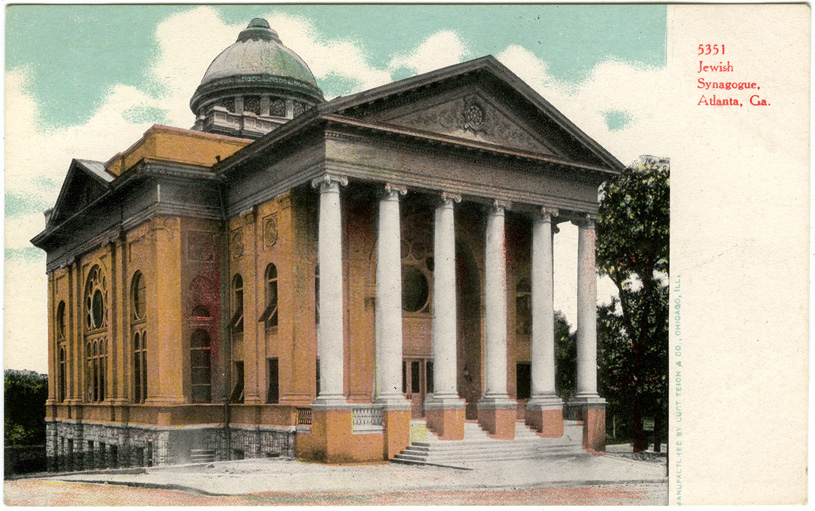6.1 Atlanta, Georgia
Hebrew Benevolent Congregation, corner of South Pryor and Richardson streets
W. F. Denny, architect, 1902
Publisher and publication date unknown
On September 12, 1902, the Hebrew Benevolent Congregation in Atlanta dedicated a large new Roman temple–style building, shown here, designed by Louisville-born W. F. Denny (1875–1905). The Atlanta Constitution called the new synagogue “one of the handsomest church buildings in the city” and “one of the most conveniently arranged.”
In other old photographs the building appears to have been mostly Renaissance in style, but it had a projecting porch facing the street, which consisted of six large Ionic columns supporting a robust Roman entablature and pediment. As Denny was the architect of the Jefferson County Courthouse, built in Louisville in 1904, it is no surprise that the synagogue looks something like a courthouse.
The spirit of ecumenicalism was associated with the new sanctuary. After the congregation replaced its previous (exotic) Moorish temple with the imposing classical edifice, one of the first major gatherings there was a citywide Thanksgiving service. As announced in the Atlanta Constitution on November 27, 1902:
This year all of the churches have made special preparation for the proper observance of the day. Excellent sermons and music of the highest order will be heard at the churches. One of the most interesting and unique services ever in the history of Atlanta churches will be held at the Temple of the Hebrew Benevolent Congregation at the corner of South Pryor and Richardson Streets, tonight at 8 o’clock . . . . The people of the city, no matter what sect or denomination, are invited to attend.
The organizer of the event, Rabbi David Marx, had taken the position of rabbi in 1895 at the age of 23, after something of a revolution had occurred in the congregation, and the more traditional Rabbi Leo Reich, who had served since 1888, was ousted. Rabbi Reich had refused to adopt the new Union Prayer Book, to reduce the holiday observance to one day, or to permit men to uncover their heads in synagogue if they desired. Marx quickly furthered Reform at Hebrew Benevolent.
The 1902 temple would serve the congregation for a quarter century, but already by the early 1920s, Rabbi Marx was eager for a new synagogue to be built—a project not realized until after 1926, when the congregation worked with the architectural firm of Hentz, Adler, and Shutze to come up with a design. Rudolph Adler, a partner in the firm and a member of the congregation, conferred with Rabbi Marx on many aspects of the plan.

